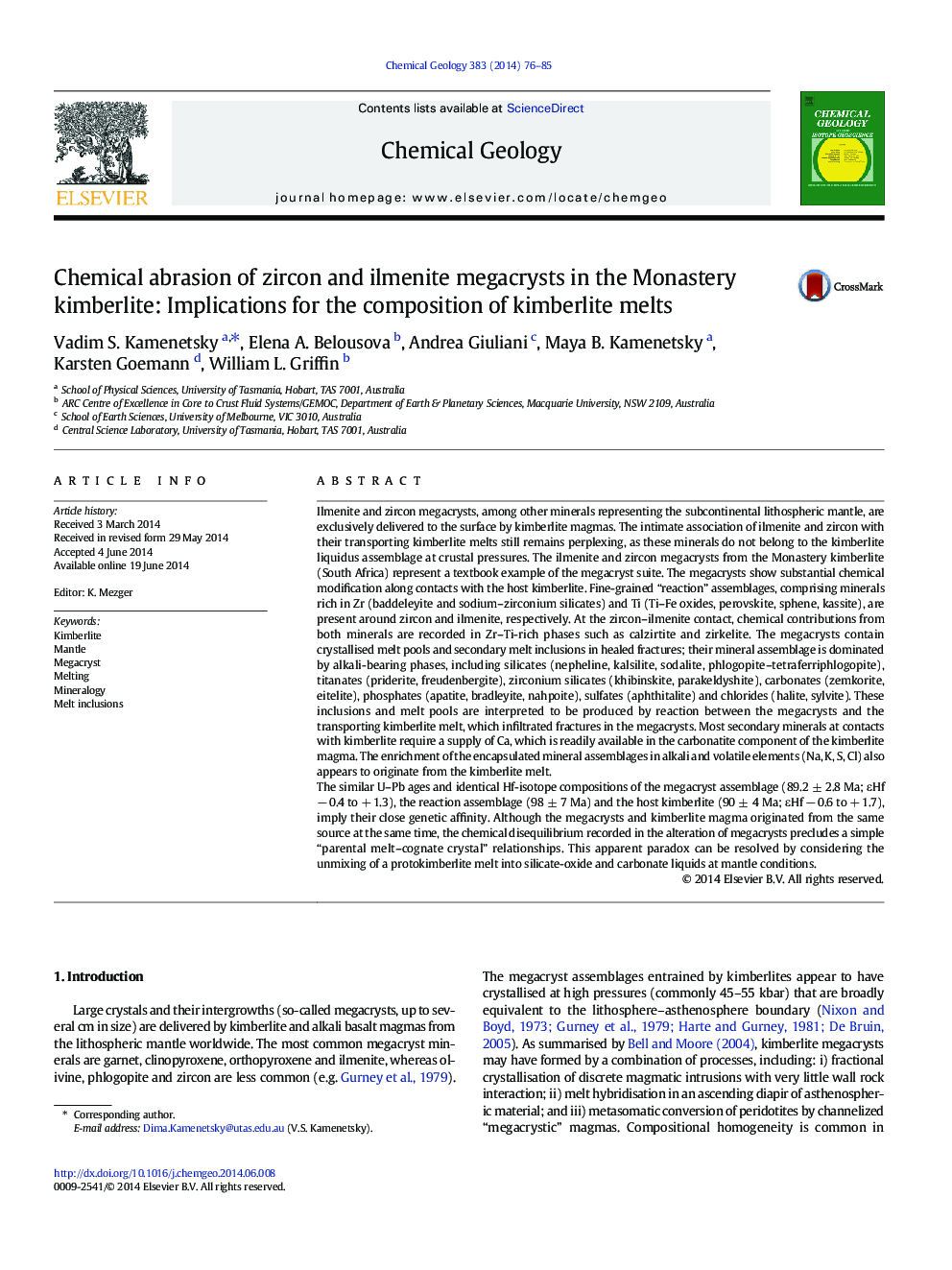| کد مقاله | کد نشریه | سال انتشار | مقاله انگلیسی | نسخه تمام متن |
|---|---|---|---|---|
| 4698679 | 1637589 | 2014 | 10 صفحه PDF | دانلود رایگان |
• Ilmenite and zircon megacrysts are delivered from the mantle by kimberlite magmas.
• The megacrysts from Monastery kimberlite have “reaction” relationships with the host.
• A reaction assemblage comprises Ti- and Zr-rich minerals, containing Ca, Na and K.
• Megacrysts and host kimberlite formed at ~ 90 Ma from a common parental melt.
• Protokimberlite melts unmixed into silicate-oxide and carbonate liquids at mantle P–T.
Ilmenite and zircon megacrysts, among other minerals representing the subcontinental lithospheric mantle, are exclusively delivered to the surface by kimberlite magmas. The intimate association of ilmenite and zircon with their transporting kimberlite melts still remains perplexing, as these minerals do not belong to the kimberlite liquidus assemblage at crustal pressures. The ilmenite and zircon megacrysts from the Monastery kimberlite (South Africa) represent a textbook example of the megacryst suite. The megacrysts show substantial chemical modification along contacts with the host kimberlite. Fine-grained “reaction” assemblages, comprising minerals rich in Zr (baddeleyite and sodium–zirconium silicates) and Ti (Ti–Fe oxides, perovskite, sphene, kassite), are present around zircon and ilmenite, respectively. At the zircon–ilmenite contact, chemical contributions from both minerals are recorded in Zr–Ti-rich phases such as calzirtite and zirkelite. The megacrysts contain crystallised melt pools and secondary melt inclusions in healed fractures; their mineral assemblage is dominated by alkali-bearing phases, including silicates (nepheline, kalsilite, sodalite, phlogopite–tetraferriphlogopite), titanates (priderite, freudenbergite), zirconium silicates (khibinskite, parakeldyshite), carbonates (zemkorite, eitelite), phosphates (apatite, bradleyite, nahpoite), sulfates (aphthitalite) and chlorides (halite, sylvite). These inclusions and melt pools are interpreted to be produced by reaction between the megacrysts and the transporting kimberlite melt, which infiltrated fractures in the megacrysts. Most secondary minerals at contacts with kimberlite require a supply of Ca, which is readily available in the carbonatite component of the kimberlite magma. The enrichment of the encapsulated mineral assemblages in alkali and volatile elements (Na, K, S, Cl) also appears to originate from the kimberlite melt.The similar U–Pb ages and identical Hf-isotope compositions of the megacryst assemblage (89.2 ± 2.8 Ma; εHf − 0.4 to + 1.3), the reaction assemblage (98 ± 7 Ma) and the host kimberlite (90 ± 4 Ma; εHf − 0.6 to + 1.7), imply their close genetic affinity. Although the megacrysts and kimberlite magma originated from the same source at the same time, the chemical disequilibrium recorded in the alteration of megacrysts precludes a simple “parental melt–cognate crystal” relationships. This apparent paradox can be resolved by considering the unmixing of a protokimberlite melt into silicate-oxide and carbonate liquids at mantle conditions.
Journal: Chemical Geology - Volume 383, 15 September 2014, Pages 76–85
